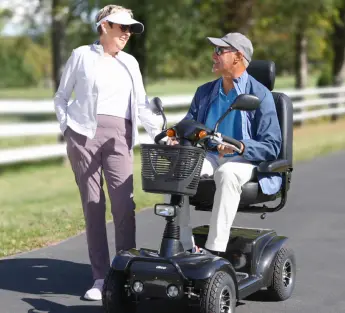Having a Manual and a Power Wheelchair
Many low-level quadriplegics have sufficient arm strength to push a manual wheelchair, perhaps aided by handrims with knobs which are easier to grasp than rims alone. Some of these riders use a manual chair at all times, while others switch between manual and power chairs, depending on distance, surface, whether they might need to be lifted up stairs, load the chair into a car, and other such criteria. You might use a power wheelchair to go to and from work, but use a manual chair at home and at the office. College students often use a power chair on campus, where they often need to travel considerable distances over hilly terrain. A blend of the two types could be the ideal strategy for your mobility. It is an approach that does not waste your energy or overuse your body.
This woman who experiences deterioration of her spine and hips finds she needs one of each:
Continuous use of my arms for moving the chair will only aggravate the problems in my shoulders, but wheeling short distances in my home would help to maintain my ability to move manually.
The power chair is the better method for outdoors because once I’m used to controlling the chair, it would actually be safer. I live in a rural area with no sidewalks and few of the places I would be going are level. Using the power chair would mean greater independence.
There have been some interesting efforts at a "best of both worlds" solution. The Roll-Aid is a motorized unit that attaches to a manual, folding wheelchair. You roll over it until the steering/control arm is between your legs, and the Roll-Aid will attach itself to your chair, allowing you to drive it like a scooter, steering with two hands rather than using a single joystick as with most power chairs.
The Quickie P200 model (now the P222) revolutionized power wheelchairs in a variety of ways. One of its unique characteristics is that the basic chair unit can be lifted off of the motor module, and then manual wheels can be attached. One user of the P200 offers an example of its versatility:
My wife and I have found this to be very handy when we arrive somewhere and find steps barring our access. We switch my chair to manual and together roll me backwards up the steps.
| Shop for a power wheelchair |





 Contact Us
Contact Us
 M-F 9am - 5pm ET
M-F 9am - 5pm ET
 Request parts
Request parts Request Service
Request Service